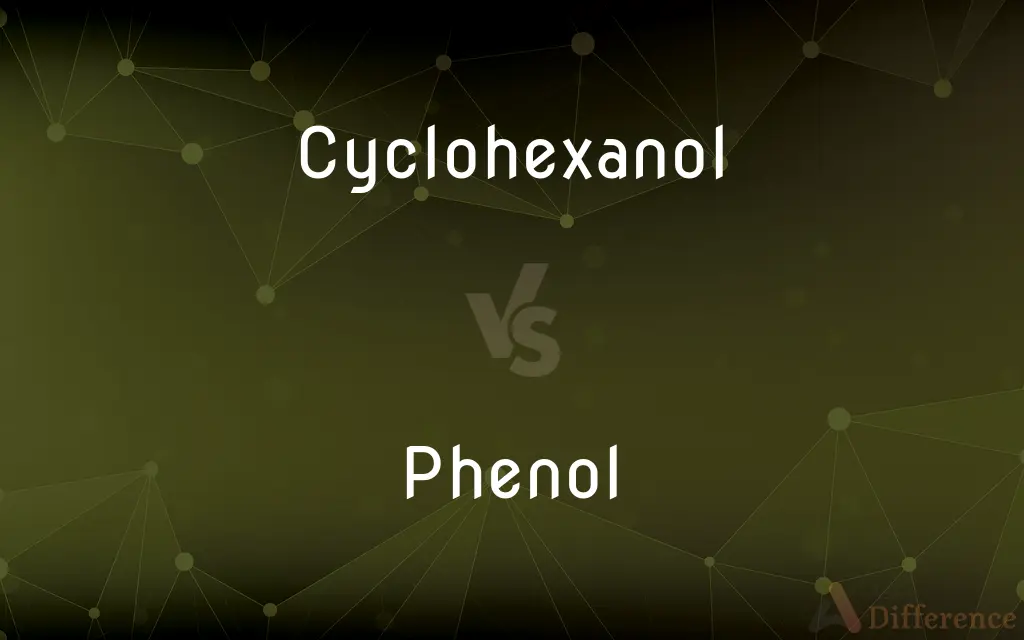Cyclohexanol vs. Phenol — What's the Difference?
By Tayyaba Rehman & Maham Liaqat — Published on February 22, 2024
Cyclohexanol is a secondary alcohol with a saturated six-membered ring, used as a precursor in chemical synthesis. Phenol, however, is an aromatic compound with a hydroxyl group attached directly to a benzene ring, known for its antiseptic properties.

Difference Between Cyclohexanol and Phenol
Table of Contents
ADVERTISEMENT
Key Differences
Cyclohexanol features a six-carbon cyclic structure similar to cyclohexane but with one hydrogen atom replaced by a hydroxyl group (–OH), making it a secondary alcohol. Its saturated ring structure means all carbon-carbon bonds are single, contributing to its relatively stable and less reactive nature compared to unsaturated or aromatic compounds. Cyclohexanol is often used as an intermediate in the production of nylon and other polymers.
Phenol, on the other hand, consists of a benzene ring with one hydrogen atom replaced by a hydroxyl group. This aromatic structure grants phenol distinct chemical properties, such as higher reactivity compared to aliphatic alcohols and the ability to undergo electrophilic substitution reactions. Phenol's aromatic nature also contributes to its somewhat polar character, influencing its solubility and chemical behavior. It has a wide range of applications, from medical antiseptics to the synthesis of plastics and pharmaceuticals.
Cyclohexanol is mainly utilized in industrial applications for producing synthetic fibers and plastics, while phenol serves a broader purpose, including its use in phenolic resins, bisphenol A production, and as a precursor for many drugs and pesticides. The difference in the chemical structure between cyclohexanol and phenol significantly affects their physical properties, reactivity, and uses.
The reactivity of cyclohexanol and phenol also diverges due to their structural differences. Cyclohexanol, being a secondary alcohol, is prone to dehydration and oxidation reactions. Phenol, with its aromatic ring, undergoes reactions characteristic of benzene derivatives, such as nitration and halogenation, which are not typical for aliphatic alcohols like cyclohexanol.
Understanding these distinctions is crucial in organic chemistry and industrial applications, as it influences how each compound is synthesized, handled, and utilized in various chemical processes and products.
ADVERTISEMENT
Comparison Chart
Chemical Structure
Saturated six-membered ring with a hydroxyl group
Benzene ring with a hydroxyl group
Type of Alcohol
Secondary alcohol
Aromatic alcohol
Reactivity
Less reactive than phenol, undergoes oxidation and dehydration
More reactive, participates in electrophilic substitution
Uses
Precursor in nylon production, solvent
Antiseptic, production of plastics, pharmaceuticals
Physical Properties
Higher boiling point due to aliphatic structure
Lower boiling point relative to aliphatic alcohols, but higher solubility in water due to aromatic ring
Compare with Definitions
Cyclohexanol
A secondary alcohol used in industrial synthesis.
Cyclohexanol is hydrogenated to produce cyclohexane.
Phenol
Soluble in water due to its polar nature.
Phenol forms hydrogen bonds with water.
Cyclohexanol
Has a saturated ring structure.
Cyclohexanol lacks double bonds in its ring.
Phenol
Undergoes electrophilic substitution.
Nitration of phenol produces nitrophenol.
Cyclohexanol
Undergoes oxidation to cyclohexanone.
Cyclohexanol is oxidized in the presence of catalysts.
Phenol
Aromatic alcohol with antiseptic properties.
Phenol is used in throat lozenges for its antibacterial effects.
Cyclohexanol
Common precursor for nylon.
Cyclohexanol is a key ingredient in adipic acid production.
Phenol
Precursor to many industrial compounds.
Phenol is used to synthesize bisphenol A.
Cyclohexanol
Less soluble in water than phenol.
Cyclohexanol's solubility is limited due to its aliphatic nature.
Phenol
Reacts with iron(III) chloride to give a violet color.
This reaction is a test for phenol's presence.
Phenol
Any of a class of aromatic organic compounds having at least one hydroxyl group attached directly to the benzene ring (or other aromatic ring)
Phenol
A toxic white soluble crystalline acidic derivative of benzene; used in manufacturing and as a disinfectant and antiseptic; poisonous if taken internally
Common Curiosities
What makes cyclohexanol different from phenol in terms of solubility?
Cyclohexanol's aliphatic structure makes it less soluble in water than phenol, which can form hydrogen bonds due to its aromatic nature.
How does the presence of the hydroxyl group affect the properties of cyclohexanol and phenol compared to their hydrocarbon counterparts?
The hydroxyl group increases polarity, boiling points, and the potential for hydrogen bonding, altering solubility and reactivity.
Can both cyclohexanol and phenol act as acids?
Yes, both can donate a hydrogen ion from their hydroxyl group, but phenol is a stronger acid due to the stability of the phenoxide ion.
What role does cyclohexanol play in the production of polymers?
Cyclohexanol is a precursor in the production of caprolactam and adipic acid, which are key monomers for the synthesis of Nylon 6 and Nylon 6,6, respectively. Its role is pivotal in creating materials with specific strength, durability, and fiber properties for various industrial applications.
Can cyclohexanol be used in the food industry?
While not directly used as a food additive, cyclohexanol derivatives can be involved in synthesizing flavors and fragrances. However, its use is strictly regulated due to its potential toxicity and is typically limited to indirect applications where it doesn't come into direct contact with consumable products.
Why is phenol more reactive towards electrophilic substitution than cyclohexanol?
Phenol's aromatic ring delocalizes the negative charge after deprotonation, stabilizing intermediates in electrophilic substitution reactions.
How do environmental impacts differ between cyclohexanol and phenol?
Phenol is considered more toxic and hazardous to the environment due to its higher reactivity and potential for bioaccumulation. Cyclohexanol, while still necessitating careful handling, generally poses a lower risk compared to phenol, which requires stringent environmental controls to mitigate its impact.
How is the acidity of phenol exploited in chemical syntheses?
The relatively high acidity of phenol (compared to alcohols) allows it to undergo reactions that form phenoxide ions, which are highly reactive species. This property is exploited in the synthesis of ethers, esters, and various aromatic compounds, enabling a wide range of chemical transformations.
Are cyclohexanol and phenol interchangeable in industrial applications?
No, their distinct chemical properties dictate specific uses, making them not interchangeable.
What advancements in chemical engineering have impacted the production and use of cyclohexanol and phenol?
Advances in catalysis and green chemistry have significantly impacted the production processes of both compounds, aiming to increase efficiency, reduce waste, and mitigate environmental impacts. For phenol, developments in direct oxidation processes have streamlined production, while for cyclohexanol, improvements in hydrogenation techniques have enhanced the sustainability and yield of its synthesis from cyclohexene.
In what way does the reactivity of cyclohexanol and phenol with bases differ?
Phenol reacts with bases to form water-soluble phenolates, a reaction utilized in purifying or isolating phenol. Cyclohexanol, being less acidic, does not readily form analogous compounds with bases, reflecting the significant influence of the aromatic ring on phenol's chemical behavior.
How do the melting and boiling points of cyclohexanol and phenol compare, and why?
Phenol generally has a higher melting point due to its ability to form stronger intermolecular hydrogen bonds compared to cyclohexanol. However, the boiling points can be relatively close, with the specific structure and intermolecular forces playing crucial roles in determining these physical properties.
What safety measures are necessary when handling cyclohexanol and phenol?
Both chemicals require careful handling due to their potential health hazards. For phenol, skin and respiratory protection are critical due to its corrosive nature and toxicity. Cyclohexanol also requires protective measures to prevent inhalation and skin contact, albeit to a slightly lesser degree. Proper ventilation, use of gloves, goggles, and face shields are recommended when handling these substances.
How does the presence of a hydroxyl group in phenol influence its electrical properties?
The hydroxyl group in phenol increases its polarity, which can enhance its electrical conductivity when in solution. This property is particularly relevant in the context of phenol's use in certain electronic applications, where its conductivity can be a valuable attribute.
What are the health risks associated with prolonged exposure to cyclohexanol and phenol?
Prolonged exposure to phenol can cause serious health issues, including skin burns, liver and kidney damage, and respiratory problems. Cyclohexanol may also pose health risks, such as irritation to the skin, eyes, and respiratory system, but generally with a lower risk profile compared to phenol.
Share Your Discovery

Previous Comparison
KH2PO4 vs. K2HPO4
Next Comparison
Hulk vs. WolverineAuthor Spotlight
Written by
Tayyaba RehmanTayyaba Rehman is a distinguished writer, currently serving as a primary contributor to askdifference.com. As a researcher in semantics and etymology, Tayyaba's passion for the complexity of languages and their distinctions has found a perfect home on the platform. Tayyaba delves into the intricacies of language, distinguishing between commonly confused words and phrases, thereby providing clarity for readers worldwide.
Co-written by
Maham Liaqat















































